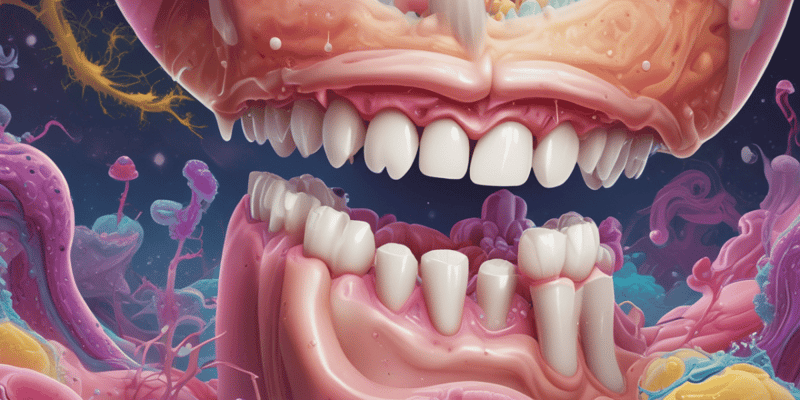10 Questions
What is an example of bacteria communicating with each other in a biofilm?
Quorum sensing
What is the main difference in behavior between bacteria growing in a biofilm and those growing in a liquid environment?
Biofilm bacteria are more resistant to antibiotics
What is the estimated increase in resistance to antibiotics of bacteria in a biofilm compared to those in a planktonic state?
1000-1500 times
What is the name of the process by which bacteria in a biofilm secrete a signaling molecule to trigger a response?
Quorum sensing
What is the main etiological factor in the initiation and promotion of periodontal diseases?
Dental plaque biofilm
What is the result of reducing the bioburden and maintaining a normal flora with appropriate oral hygiene methods?
Reduced risk of periodontal diseases
What is the primary goal of oral hygiene methods such as daily brushing, flossing, and rinsing with antimicrobial mouthrinses?
To reduce the bioburden and maintain a normal flora
What is the name of the book that is a reference for periodontology and implant dentistry?
Newman & Carranza`s Clinical Periodontology
What is the ISBN of the book 'Newman & Carranza`s Clinical Periodontology' 13th Edition?
9780323523004
What is the ISBN of the book 'Niklaus P Lang & Jan Lindhe Clinical Periodontology and Implant Dentistry' 6th Edition?
9780470672488
Study Notes
Biofilms and Dental Plaque
- Biofilms are composed of microbial cells encased within a matrix of extracellular polymeric substances, such as polysaccharides, proteins, and nucleic acids.
- Dental plaque is a type of biofilm that is composed primarily of microorganisms encased within an extracellular matrix.
- One gram of plaque (wet weight) contains approximately 10^11 bacteria.
Composition of Dental Plaque
- Organic constituents of the matrix include polysaccharides, proteins, glycoproteins, lipid material, and DNA.
- Inorganic components of plaque are predominantly calcium and phosphorus, with trace amounts of other minerals, such as sodium, potassium, and fluorine.
Classification of Dental Plaque
- Dental plaque is classified as supragingival or subgingival on the basis of its position on the tooth surface toward the gingival margin.
- Supragingival plaque is found at or above the gingival margin; when in direct contact with the gingival margin, it is referred to as marginal plaque.
- Subgingival plaque is found below the gingival margin, between the tooth and the gingival pocket epithelium.
Formation of Dental Plaque
- The process of plaque formation can be divided into several phases: formation of the pellicle on the tooth surface, initial adhesion/attachment of bacteria, and colonization/plaque maturation.
- The acquired pellicle is a layer of organic material that coats all surfaces in the oral cavity, including the hard and soft tissues.
- The bacteria that adhere to tooth surfaces do not contact the enamel directly but interact with the acquired enamel pellicle.
Interaction Between Bacteria and the Pellicle
- The specific interactions between microbial cell surface “adhesin” molecules and receptors in the salivary pellicle determine whether a bacterial cell will remain associated with the surface.
- Primary colonizers provide new binding sites for adhesion by other oral bacteria through coadhesion.
- The metabolic activity of the primary colonizers modifies the local microenvironment in ways that can influence the ability of other bacteria to survive in the dental plaque biofilm.
Coaggregation and Secondary Colonization
- Coaggregation is the ability of bacteria to adhere to different species and genera of microorganisms.
- Well-characterized interactions of secondary colonizers with early colonizers include the coaggregation of F. nucleatum with S. sanguinis, Prevotella loescheii with A. oris, and Capnocytophaga ochracea with A. oris.
- Secondary colonizers such as P. intermedia, P. loescheii, Capnocytophaga spp., F. nucleatum, and P. gingivalis do not initially colonize clean tooth surfaces but rather adhere to bacteria that are already in the plaque mass.
Nonspecific and Specific Plaque Hypothesis
- The nonspecific plaque hypothesis states that it is the total bulk of plaque, which determines the pathogenicity rather than the individual species within it.
- The specific plaque hypothesis states that not all plaque is pathogenic and its pathogenicity depends on the presence of certain specific microbial pathogens in plaque.
- The ecological plaque hypothesis states that both the total amount of dental plaque and the specific microbial composition of plaque may contribute to the transition from health to disease.
Communication Between Bacteria in a Biofilm
- In a biofilm, bacteria have the capacity to communicate with each other through quorum sensing, in which bacteria secrete a signaling molecule that accumulates in the local environment and triggers a response such as a change in the expression of specific genes.
- Organisms in a biofilm are 1000-1500 times more resistant to antibiotics as compared to their planktonic state.
Management of Dental Plaque
- Dental plaque biofilm cannot be eliminated permanently, but its pathogenic nature can be reduced by reducing the bioburden and maintaining a normal flora with appropriate oral hygiene methods.
- This can result in the prevention or management of the associated sequelae, including the development of periodontal diseases.
Explore the composition and characteristics of dental plaque and biofilms, including their microbial cells and extracellular matrix. Learn about the importance of dental plaque in oral health.
Make Your Own Quizzes and Flashcards
Convert your notes into interactive study material.
Get started for free



